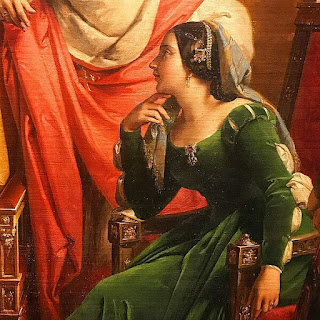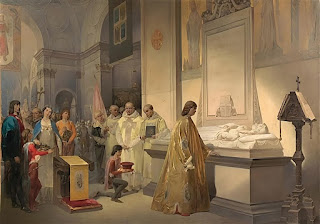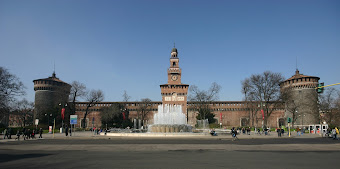Carlo Levi – writer and painter
Author and doctor who highlighted poverty in southern Italy
The anti-Fascist writer, painter and doctor, Carlo Levi, died on this day in Rome in 1975. He is best remembered for his book Christ Stopped at Eboli - Cristo si è fermato a Eboli - an account of the time he spent in political exile in a remote, impoverished part of Italy. Levi was born in Turin in 1902. His father was a wealthy Jewish physician and Levi went to the University of Turin to study medicine after finishing school. While at University he became active in politics and after graduating he turned his attention to painting. But he never completely abandoned medicine and moved to Paris to continue his medical research while painting. After returning to Italy, Levi founded an anti-Fascist movement in 1929. As a result he was arrested and sent into exile to a remote area of Italy called Lucania (now renamed Basilicata). He encountered extreme poverty, which had been unknown in the north where he grew up. As well as writing and painting while he was in exile, he served as a doctor to help the poor villagers he lived among. When he was released from his political exile he moved back to France but on his return to Italy he was arrested again. Read more…
_______________________________________
Pino Daniele - singer and songwriter
Naples mourned star with flags at half-mast
The Neapolitan singer-songwriter Pino Daniele died on this day in 2015 in hospital in Rome. Daniele, whose gift was to fuse his city’s traditional music with blues and jazz, suffered a heart attack after being admitted with breathing difficulties. Daniele, who had a history of heart problems, had been taken to Rome after falling ill at his holiday home in Tuscany. On learning of his death, the Naples mayor Luigi de Magistris ordered that flags on municipal buildings in the city be flown at half-mast. Born in 1955, Daniele grew up in a working class family in the Sanità neighborhood of Naples, once a notorious hotbed of crime. His father worked at the docks. As a musician, he was self-taught, mastering the guitar with no formal lessons and developing a unique voice, alternately soaring and soft, and gravelly to the point of sounding almost hoarse. He named the great American jazz musicians Louis Armstrong and George Benson as his major influences but also drew deeply on the life, culture and traditions of his home city, which he loved. His songs sometimes combined Italian, English and Naples dialect. Read more…
_____________________________________
Gaetano Merola – conductor and impresario
Neapolitan who founded the San Francisco Opera
Gaetano Merola, a musician from Naples who emigrated to the United States and ultimately founded the San Francisco Opera, was born on this day in 1881. Merola directed the company and conducted many performances for 30 years from its opening night in September 1923 until his death in August 1953. He literally died doing what he loved, collapsing in the orchestra pit while conducting the San Francisco Symphony Orchestra during a concert at an outdoor amphitheatre in the city. The son of a violinist at the Royal Court in Naples, Merola studied piano and conducting at the Conservatorio di San Pietro a Majella in Naples, graduating with honours at the age of 16. Three years later he was invited to New York to work as assistant to Luigi Mancinelli, another Italian emigrant, born in Orvieto, who was a noted composer and cellist who was lead conductor of the New York Metropolitan Opera. Demand for his services grew and he made regular guest appearances with companies across America and beyond, including a stint at Oscar Hammerstein’s London Opera House on the site of what is now the Peacock Theatre in Holborn. Read more…
____________________________________
Giovanni Battista Pergolesi – composer
Brief career of 'opera buffa' genius
Opera composer Giovanni Battista Pergolesi was born on this day in 1710 as Giovanni Battista Draghi, in Jesi, in what is now the province of Ancona. He later acquired the name Pergolesi, the Italian word for the residents of Pergola in Marche, which had been the birthplace of his ancestors. Pergolesi was the most important early composer of opera buffa - comic opera. He wrote a two-act buffa intermezzo for one of his serious operas, which later became a popular work in its own right. He also wrote sacred music and his Stabat Mater, composed in 1736, has been used in the soundtracks of many contemporary films. Pergolesi received a musical education at the Conservatorio dei Poveri in Naples where he gained a good reputation as a violinist. In 1732 he was appointed maestro di cappella to the Prince of Stigliano in Naples and produced for him an opera buffa, Lo frate ‘nnammorato, and a sacred work, believed to be his Mass in D, which were both well received. The following year his serious opera, Il prigionier superbo, was produced but it was the comic intermezzo, La serva padrona, inserted between the acts, that was most popular, revealing his gift for comic characterisation. Read more…
_____________________________________
Giuseppe ‘Pino’ Greco - Mafia executioner
Notorious hitman thought to have committed at least 80 murders
The notorious Mafia hitman Giuseppe Greco, who was convicted posthumously on 58 counts of murder but whose victims possibly ran into hundreds, was born on this day in 1952 in Ciaculli, a town on the outskirts of Palermo in Sicily. More often known as ‘Pino’, or by his nickname Scarpuzzedda - meaning ‘little shoe’ - Greco is considered one of the most prolific killers in the history of organised crime. The nephew of Michele Greco, who lived on an estate just outside Ciaculli and rose to be head of the Sicilian Mafia Commission - a body set up to settle disputes between rival clans - Pino Greco is generally accepted to have been responsible for 80 deaths, although some students of Cosa Nostra history believe he could have committed more than 300 killings. Most of Greco’s victims were fellow criminals, the majority of them killed during the Second Mafia War, which began in 1978 and intensified between 1981 and 1983 with more than 1,000 homicides, as rival clans fought each other and against the state, with judges, prosecutors and politicians prominent in the fight against organised crime themselves becoming targets. Read more…
____________________________________
Book of the Day: Christ Stopped at Eboli, by Carlo Levi
'We're not Christians, Christ stopped short of here, at Eboli.' Exiled to a remote and barren corner of southern Italy for his opposition to Mussolini, Carlo Levi entered a world cut off from history and the state, hedged in by custom and sorrow, without comfort or solace, where, eternally patient, the peasants lived in an age-old stillness and in the presence of death - for Christ did stop at Eboli. A searing account of his exile in rugged Basilicata, Levi’s memoir is a powerful polemic against fascism and the calculated impoverishment of the peasantry during Mussolini’s regime. Heartrending and angry, yet with a beautifully cultivated sense of time and place, Christ Stopped at Eboli is a book that deserves to be read. Levi's lucid, non-ideological and sympathetic description of the daily hardships experienced by the local peasants helped to propel the ‘problem of the South’ into national discourse after the end of World War II.Carlo Levi was an Italian painter, writer, activist, independent leftist politician and doctor.



.jpg)





.jpg)
.jpg)
.jpg)

.jpg)








.jpg)
.jpg)
